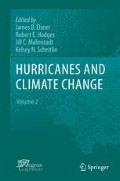Abstract
In this chapter, we demonstrate the existence of environmental signals in property damage losses from hurricanes affecting the United States. The methodology is based on a random sums model, where the number of damaging hurricane events is modeled separately from the amount of damage per event. It is shown that when the springtime north-south surface pressure gradient over the North Atlantic is weaker than normal, the Atlantic ocean is warmer than normal, there is no El Niño event, and sunspots are few, the probability of at least one loss event increases. However, given at least some losses, the magnitude of the damage per annum is correlated only to ocean temperatures in the Atlantic. The magnitude of damage losses at a return period of 50 years is largest under a scenario featuring a warm Atlantic Ocean, a weak North Atlantic surface pressure gradient, El Niño, and few sunspots.
Access this chapter
Tax calculation will be finalised at checkout
Purchases are for personal use only
References
Coles S (2001) An introduction to statistical modeling of extreme values. Springer, New York
Coles S, Tawn JA (1996) A Bayesian analysis of extreme rainfall data. Appl Stat 45:463–478
Coles S, Pericchi LR, Sisson S (2003) A fully probabilistic approach to extreme rainfall modeling. J Hydrol 273:35–50
Elsner JB, Jagger TH (2004) A hierarchical Bayesian approach to seasonal hurricane modeling. J Climate 17:2813–2827
Elsner JB, Jagger TH (2006) Prediction models for annual U.S. hurricane counts. J Climate 19:2935–2952
Elsner JB, Jagger TH (2008) United States and Caribbean tropical cyclone activity related to the solar cycle. Geophys Res Lett 35:L18705, doi:10.1029/2008/GL034431
Elsner JB, Bossak BH, Niu X-F (2001) Secular changes to the ENSO-U.S. hurricane relationship. Geophys Res Lett 28:4123–4126
Elsner JB, Niu X-F, Jagger TH (2004) Detecting shifts in hurricane rates using a Markov Chain Monte Carlo approach. J Climate 17:2652–2666
Elsner JB, Kossin JP, Jagger TH (2008) The increasing intensity of the strongest tropical cyclones. Nature 455:92–95
Emanuel KA (1991) The theory of hurricanes. Ann Rev Fluid Mechan 23:179–196
Gilks WR, Richardson S, Spiegelhalter DJ (1996) Markov Chain Monte Carlo in practice. Chapman & Hall/CRC, London
Hsieh PH (2004) A data-analytic method for forecasting next record catastrophe loss. J Risk Insur 71:309–322
Jagger TH, Elsner JB (2006) Climatology models for extreme hurricane winds near the United States. J Climate 19:3220–3236
Jagger TH, Elsner JB, Niu X-F (2001) A dynamic probability model of hurricane winds in coastal counties of the United States. J Appl Meteorol 40:853–863
Jagger TH, Elsner JB, Saunders MA (2008) Forecasting U.S. insured hurricane losses. In: Murnane R, Diaz H (eds) Climate extremes and society. Cambridge University Press, Cambridge
Jones PD, Jónsson T, Wheeler D (1997) Extension to the North Atlantic oscillation using early instrumental pressure observations from Gibraltar and south-west Iceland. Int J Climatol 17:1433–1450
Katz RW (2002) Stochastic modeling of hurricane damage. J Appl Meteorol 41:754–762
Katz RW, Parlange MB, Naveau P (2002) Statistics of extremes in hydrology. Adv Water Resour 25:1287–1304
Lane MN (2008a) Beyond convergence, toward integration. Trade Notes, Lane Financial LLC, August 29, 2008
Lane MN (2008b) The measurement of ILS returns. Trade Notes, Lane Financial LLC, August 29, 2008
Leckebusch GC, Ulbrich U, Fröhlich L, Pinto JG (2007) Property loss potentials for European midlatitude storms in a changing climate. Geophys Res Lett 34:L05703, doi:10.1029/2006GL027663
Murnane RJ, Barton C, Collins E, Donnelly J, Elsner J, Emanuel K, Ginis I, Howard S, Landsea C, Liu K-B, Malmquist D, McKay M, Michaels A, Nelson N, O’Brien J, Scott D, Webb T (2000) Model estimates hurricane wind speed probabilities. Eos Trans Amer Geophys Union 81:433–438
Pielke RA, Gratz J, Landsea CW, Collins D, Saunders MA, Musulin R (2008) Normalized hurricane damage in the United States 1900–2005. Nat Hazards Rev 9(1):29–42
Ropelewski CF, Jones PD (1997) An extension of the Tahiti-Darwin southern oscillation index. Monthly Weather Rev 115:2161–2165
Saunders MA, Lea AS (2005) Seasonal prediction of hurricane activity reaching the coast of the United States. Nature 434:1005–1008
Spiegelhalter DJ, Best NG, Gilks WR, Inskip H (1996) Hepatitis B: a case study in MCMC methods. In: Gilks WR, Richardson S, Spiegelhalter DJ (eds) Markov chain Monte Carlo in practice. Chapman & Hall/CRC, London, pp 21–43
Spiegelhalter DJ, Best NG, Carlin BP, van der Linde A (2002) Bayesian measures of model complexity and fit (with discussion). J Roy Stat Soc Ser B 64, Part q4:583–639
Walshaw D (2000) Modeling extreme wind speeds in regions prone to hurricanes. Appl Stat 49: 51–62
Acknowledgements
This research is supported by Florida State University’s Catastrophic Storm Risk Management Center, the Risk Prediction Initiative of the Bermuda Institute for Ocean Studies (RPI-08-02-002), and by the U.S. National Science Foundation (ATM-0738172). The views expressed within are those of the authors and do not reflect those of the funding agency.
Author information
Authors and Affiliations
Corresponding author
Editor information
Editors and Affiliations
Rights and permissions
Copyright information
© 2010 Springer Science+Business Media B.V.
About this chapter
Cite this chapter
Jagger, T.H., Elsner, J.B., Burch, R.K. (2010). Environmental Signals in Property Damage Losses from Hurricanes. In: Elsner, J., Hodges, R., Malmstadt, J., Scheitlin, K. (eds) Hurricanes and Climate Change. Springer, Dordrecht. https://doi.org/10.1007/978-90-481-9510-7_6
Download citation
DOI: https://doi.org/10.1007/978-90-481-9510-7_6
Published:
Publisher Name: Springer, Dordrecht
Print ISBN: 978-90-481-9509-1
Online ISBN: 978-90-481-9510-7
eBook Packages: Earth and Environmental ScienceEarth and Environmental Science (R0)

